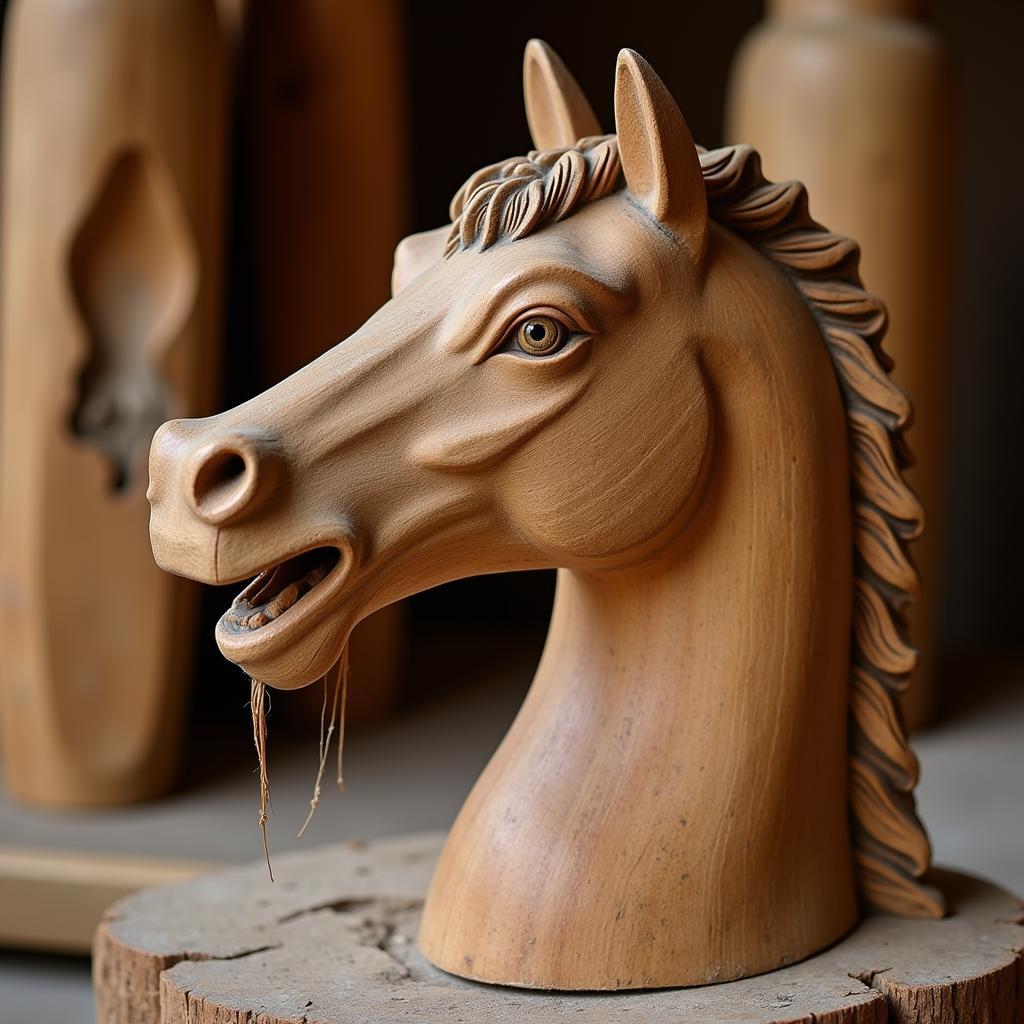Horse Carvings have captivated art enthusiasts and equestrians alike for centuries. These sculptures, crafted from various materials, embody the grace, strength, and spirit of horses, making them timeless additions to homes, gardens, and galleries. Whether you’re a seasoned collector or simply drawn to the allure of equine art, exploring the world of horse carvings reveals a rich tapestry of history, craftsmanship, and artistic expression.
A Gallop Through Time: The History of Horse Carvings
 Ancient Horse Carvings in Cave Paintings
Ancient Horse Carvings in Cave Paintings
From the earliest cave paintings depicting horses in motion to the intricate sculptures adorning ancient temples, the bond between humans and horses has long been immortalized through art. Early civilizations, recognizing the horse’s vital role in transportation, warfare, and agriculture, revered these creatures. Evidence of this deep respect can be found in the form of horse carvings dating back thousands of years.
Ancient Greek sculptors, masters of capturing movement and form, immortalized horses in bronze and marble. Roman artisans, inspired by Greek traditions, adorned their cities with equestrian statues celebrating emperors and military victories. Throughout history, different cultures have developed their unique styles of horse carvings, reflecting their individual artistic sensibilities and the significance of horses in their societies.
Materials and Methods: From Wood to Bronze
 Horse Carving in Wood – Intricate Detail
Horse Carving in Wood – Intricate Detail
Horse carvings are brought to life through a wide array of materials, each offering its own unique characteristics and challenges for the artist. Wood, with its natural warmth and versatility, has been a favored medium for centuries. From small, intricately carved figurines to life-size wooden horses, the beauty of the grain and the skill of the carver combine to create stunning works of art.
Bronze, a metal alloy known for its durability and ability to capture fine detail, has been a popular choice for equestrian statues and sculptures for millennia. The casting process allows for intricate designs and dynamic poses, making bronze horse carvings particularly captivating. Other materials used in horse carvings include stone, clay, resin, and even contemporary materials like glass and metal.
Styles of Horse Carvings: Realism to Abstraction
Just as artistic styles have evolved over time, so too have the ways in which horses are depicted in carvings. Realism, with its focus on anatomical accuracy and lifelike detail, has been a dominant style throughout history. Sculptors strive to capture the horse’s musculature, the texture of its coat, and even the glint in its eye, creating works that are strikingly true to life.
Abstract horse carvings, on the other hand, explore the essence of the horse through form, line, and movement, often simplifying or exaggerating features to evoke emotion and interpretation. These sculptures can be incredibly powerful, encouraging viewers to connect with the horse on a more symbolic or emotional level.
Horse Carvings in Your Life: From Decor to Collectibles
Whether you’re an experienced collector or simply searching for a unique piece to enhance your home, horse carvings offer a wide range of options to suit every taste and budget. Small, handcrafted figurines make charming additions to bookshelves or mantels, while larger sculptures can serve as striking focal points in gardens or living spaces.
For those seeking investment pieces, antique horse carvings or works by renowned artists can appreciate in value over time. No matter your preference, incorporating horse carvings into your life allows you to celebrate the beauty, power, and enduring appeal of these magnificent animals.
FAQs About Horse Carvings:
1. What are the most valuable horse carvings?
The value of a horse carving depends on factors such as the artist, age, materials used, condition, and historical significance. Antique bronze sculptures by renowned artists are typically highly sought after by collectors.
2. What type of wood is best for horse carving?
Basswood, butternut, and tupelo are popular choices for their workability and fine grain. Hardwoods like oak and walnut offer durability and a beautiful grain pattern but can be more challenging to carve.
3. How do I care for a bronze horse sculpture?
Regular dusting with a soft cloth is essential. Avoid using abrasive cleaners. Apply a quality wax designed for bronze once or twice a year to protect the patina and prevent tarnishing.
4. Can I display a wooden horse carving outdoors?
While some hardwoods are naturally resistant to decay, it’s best to display wooden carvings indoors or in a protected outdoor area. Direct sunlight and moisture can damage the wood over time.
5. Where can I find reputable dealers of antique horse carvings?
Reputable antique shops, art galleries, and online auction houses specializing in sculptures are good places to start. Research dealers thoroughly and ask for documentation of authenticity.
Still Have Questions?
We’re here to help you navigate the world of equine care! If you have any further questions or need expert advice, don’t hesitate to reach out. Contact us at Phone Number: 0772127271, Email: [email protected], or visit our location at QGM2+WX2, Vị Trung, Vị Thuỷ, Hậu Giang, Việt Nam. Our dedicated customer support team is available 24/7 to assist you.